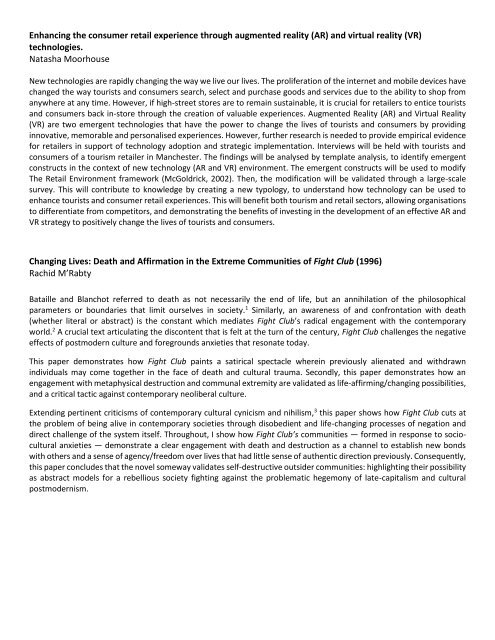Conference Programme FULL (1)
Create successful ePaper yourself
Turn your PDF publications into a flip-book with our unique Google optimized e-Paper software.
Enhancing the consumer retail experience through augmented reality (AR) and virtual reality (VR)<br />
technologies.<br />
Natasha Moorhouse<br />
New technologies are rapidly changing the way we live our lives. The proliferation of the internet and mobile devices have<br />
changed the way tourists and consumers search, select and purchase goods and services due to the ability to shop from<br />
anywhere at any time. However, if high-street stores are to remain sustainable, it is crucial for retailers to entice tourists<br />
and consumers back in-store through the creation of valuable experiences. Augmented Reality (AR) and Virtual Reality<br />
(VR) are two emergent technologies that have the power to change the lives of tourists and consumers by providing<br />
innovative, memorable and personalised experiences. However, further research is needed to provide empirical evidence<br />
for retailers in support of technology adoption and strategic implementation. Interviews will be held with tourists and<br />
consumers of a tourism retailer in Manchester. The findings will be analysed by template analysis, to identify emergent<br />
constructs in the context of new technology (AR and VR) environment. The emergent constructs will be used to modify<br />
The Retail Environment framework (McGoldrick, 2002). Then, the modification will be validated through a large-scale<br />
survey. This will contribute to knowledge by creating a new typology, to understand how technology can be used to<br />
enhance tourists and consumer retail experiences. This will benefit both tourism and retail sectors, allowing organisations<br />
to differentiate from competitors, and demonstrating the benefits of investing in the development of an effective AR and<br />
VR strategy to positively change the lives of tourists and consumers.<br />
Changing Lives: Death and Affirmation in the Extreme Communities of Fight Club (1996)<br />
Rachid M’Rabty<br />
Bataille and Blanchot referred to death as not necessarily the end of life, but an annihilation of the philosophical<br />
parameters or boundaries that limit ourselves in society. 1 Similarly, an awareness of and confrontation with death<br />
(whether literal or abstract) is the constant which mediates Fight Club’s radical engagement with the contemporary<br />
world. 2 A crucial text articulating the discontent that is felt at the turn of the century, Fight Club challenges the negative<br />
effects of postmodern culture and foregrounds anxieties that resonate today.<br />
This paper demonstrates how Fight Club paints a satirical spectacle wherein previously alienated and withdrawn<br />
individuals may come together in the face of death and cultural trauma. Secondly, this paper demonstrates how an<br />
engagement with metaphysical destruction and communal extremity are validated as life-affirming/changing possibilities,<br />
and a critical tactic against contemporary neoliberal culture.<br />
Extending pertinent criticisms of contemporary cultural cynicism and nihilism, 3 this paper shows how Fight Club cuts at<br />
the problem of being alive in contemporary societies through disobedient and life-changing processes of negation and<br />
direct challenge of the system itself. Throughout, I show how Fight Club’s communities — formed in response to sociocultural<br />
anxieties — demonstrate a clear engagement with death and destruction as a channel to establish new bonds<br />
with others and a sense of agency/freedom over lives that had little sense of authentic direction previously. Consequently,<br />
this paper concludes that the novel someway validates self-destructive outsider communities: highlighting their possibility<br />
as abstract models for a rebellious society fighting against the problematic hegemony of late-capitalism and cultural<br />
postmodernism.


